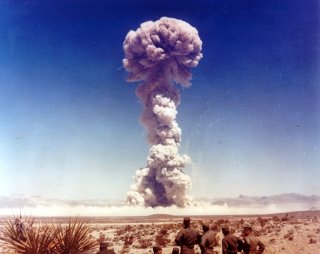A War Game Was NATO’s First Glimpse Into How a Nuclear War Would Be Hell
And millions would die.
Throughout the Cold War, the prospect of nuclear war hung over Europe like a recurring nightmare. But in the early years of the Atomic Age, most people only dimly understood the consequences of tactical nuclear war. It wasn’t until nearly a decade into the superpower contest that Europe’s nightmare gained a vivid, terrifying clarity.
That clarity came from Carte Blanche, NATO’s first major exercise to simulate what a nuclear exchange with the Soviets on the continent would look like.
When officials finally tallied the numbers, the theoretical war’s toll on Germany included 1.7 million dead and 3.5 million wounded — killing more people in a matter of hours than strategic bombing had taken during the entirety of World War II.
The results of exercise shocked and horrified citizens in NATO countries, especially in West Germany — ground zero for any war with the Soviets, and alarmed their leadership. For years afterward, Carte Blanche shaped attitudes toward nuclear weapons and their role in defense of Europe.
After the United States dropped atomic bombs on Hiroshima and Nagasaki in 1945, the world broadly understood that nuclear weapons possessed unprecedented destructive power. But a grasp of weapons’ specific impact — especially that of smaller, tactical nukes — was more elusive.
That was especially true for America’s NATO allies, which lacked both nuclear weapons of their own and the kind of detailed understanding of their capabilities and effects that came from development and ownership of the weapons. The development of tactical nuclear weapons and strategy drove the need to game out what a nuclear war might look like.
Tactical nukes packed a smaller yield than their larger strategic cousins. The logic behind using them held that the weapons were large enough to offset NATO’s disadvantage against the conventionally superior Soviet forces.
Though using them would be a form of nuclear war, they were — in theory — small enough to help contain a war to a single, local theater such as Europe, without the combatants having to resort to a globe-spanning exchange of larger, strategic weapons.
In 1954, NATO officially approved the use of tactical nuclear weapons in its defense. “It is militarily essential that NATO forces should be able to use atomic and thermonuclear weapons in their defense,” the alliance’s “MC 48” decision stated.
If the alliance was going to contemplate the use of tactical nuclear weapons, it also had to conduct exercises simulating their use … in order to understand the effects and NATO’s strengths and weakness on the atomic battlefield.
That same year, the allies had already practiced a more limited nuclear engagement during Battle Royal, which had simulated the detonations of just 10 atomic shells against a theoretical Soviet tank division.
Carte Blanche, however, was a much larger affair — and more commensurate with the scale of a likely war with the Soviets. Eleven countries participated, conducting over 12,000 aerial sorties deploying more than 300 fictional nuclear weapons.
Carte Blanche recycled Battle Royal’s anodyne characterization of the stand-ins for NATO and Communist forces. “Southland,” headquartered in Trier and played by American, Canadian and French forces, assumed the role of NATO forces. The Fourth Allied Tactical Air Force provided air support along with the U.S. Sixth Fleet based in the Mediterranean and the 49th Air Division.
Belgian, British and Dutch forces took up the mantle of Northland, the Soviet aggressor in the exercise, headquartered in Mönchengladbach and supported by the Second Allied Tactical Air Force.
The exercise was mostly an air war, spread out over six days in the summer of 1955. Organizers distributed roughly 2,500 planes between the sides, giving the pretend Soviets slightly more aircraft.
Exercise referees moderated the pace of the conflict, telling air base inhabitants when they’d been hit by a nuclear bomb, the distance it had landed from them and the damage it had done.
British Air Commodore Peter Wykeham-Barnes, Chief of Staff of Allied Air Forces in Europe, briefed the press on the results of Carte Blanch. Tactical nuclear war, Wykeham-Barnes concluded, favored the aggressor — in this case, the mock-Soviets of Northland.
Nonetheless, “in an all-out atomic war, there would be no winners and no losers and little left to assess,” he said. Any similar conflict would be “short and horrible.”
Someone leaked details to West Germany’s Der Spiegel newspaper. According to the leaked info, targets in West Germany had borne the theoretical brunt of the exercise, with 268 of the 335 mock nuclear weapons detonating inside the country.
Exercise officials calculated 1.7 million dead.
The public was understandably frightened … and outraged. Polls showed increases in domestic opposition to nuclear weapons.
Writing shortly after the exercise, Henry Kissinger — then still an academic — concluded that Carte Blanche had become “a demonstration that the power of nuclear weapons inhibits their use unless there exists a doctrine which poses alternatives less stark than total devastation.”
Though NATO anxiety was high after its first up-close glimpse of nuclear war, Carte Blanche did not undo the overall consensus on the need for tactical nuclear weapons in Europe.
But it did compel countries including West Germany to push for a greater say in NATO’s nuclear strategy, resulting in greater U.S. consultation with its allies in the form of NATO’s Nuclear Planning Group.
This article by Adam Rawnsley originally appeared at War is Boring in 2015.
Image: Wikimedia

